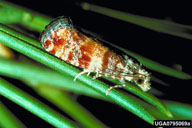A Guide to Common Forest Pests in Georgia
Terry Price, Forest Health Specialist, Georgia Forestry Commission
Pine Tip Moths
|
There are three species of pine tip moths occurring in Georgia: the Nantucket pine tip moth, Ryacionia frustrana, the pitch pine tip moth, R. rigidana; and the subtropical pine tip moth, R. subtropicana.
The Nantucket pine tip moth is the most widely distributed species and causes the most damage to recently planted pines. All native pines up to about 15 feet in height are attacked except longleaf and eastern white pines. Although slash pine is highly resistant, it may be attacked when planted on poor sites. Loblolly pine and shortleaf pines are the favored hosts. Severe and repeated attacks often result in stunted, bushy, and deformed trees. Loblolly pines can be seriously stunted when planted on droughty soils (Figure 21).
The adult Nantucket pine tip moth is about 1/4" in length with irregular brick red and coppery patches on the forewings (Figure 22). The wing span is about 1/2". Sometimes the pitch pine moth is found with the Nantucket pine tip moth and positive field identification is difficult. However, they have similar habits. The larvae of both species are small, yellowish to brownish and are approximately 3/8", in length.
The adult moths (Nantucket) of the overwintering generation emerge in early spring. Depending on weather conditions, spring emergence may occur as early as January in extreme south Georgia or as late as April in north Georgia. Egg laying begins soon after adult emergence. The temperature greatly influences the incubation period. After the larvae hatch they begin to feed on new shoots near the base of the needles or the base of the buds. A protective web is spun over their bodies while they feed. Eventually this web becomes covered with pitch and is a characteristic sign of tip moth infestations in the tips of seedlings (Figure 23). When the larvae have completed their development, a cocoon is spun in the hollowed out shoot tip and pupation occurs within. Winter is passed as pupae within the injured tips. Two to four generations occur per year in Georgia.
|

Figure 21 - Repeated tip moth attacks cause undesirable bushing in seedlings.
Photo by Terry Price, GFC |

Figure 22 - Nantucket pine tip moth
Photo by James Richmond, USFS |

Figure 23 - Resin mass indicating a tip moth attack
Photo by Terry Price, GFC |
The subtropical pine tip moth is found in south Georgia on slash pine. Damage is usually of no significance but control may be justified in newly established tree improvement orchards.
Control of the Nantucket pine tip moth in Christmas tree plantations and in newly established seed orchard plantings is best achieved by deploying pheromone baited traps. These traps help determine moth emergence so that insecticide applications will coincide with egg laying and larval hatching. A lot of managers make the mistake of applying an insecticide every 2-4 weeks from March to September in hopes of suppressing moth populations. Improperly timed insecticide applications are of no benefit and in most cases create problems with various scale insects by killing off their natural enemies. Infested tips can be pruned and burned if time and labor permit.
Georgia Forest Research Paper #44, "How To Time Dimethoate Sprays Against The Nantucket Pine Tip Moth," is available from any Georgia Forestry Commission office. The information in the paper can help Christmas tree growers determine their spraying schedules. There are also a few private entomology consultants that are available in Georgia that will deploy the pheromone traps for growers and set up spray schedules for them. More information can be obtained by writing Georgia Forestry Commission, P. 0. Box 819, Macon, Georgia 31298-4599.
[ Contents ]
[ Previous ]
[ Next ]
[ Home ]
|





